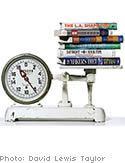
To the dismay of nutritionists—and the delight of diet book publishers—when the majority of Americans want to drop pounds, they think less about long-term lifestyle changes and more about quick fixes. In fact, between 2002 and 2003, diet titles more than doubled their share of overall book sales. To see if any are worth buying, we asked LLuminari, O's team of doctors and nutritionists, to investigate. Each diet was put through a rigorous analysis to determine how many calories it actually gives you in a day (most don't say), what percentage is fat, and whether it has nutritional deficiencies. One point all the experts stressed before starting is that even the best-rated diet won't work unless it's paired with an exercise regimen.
The Books
Browse the latest!
- The South Beach Diet
- The L.A. Shape Diet
- The New Glucose Revolution
- The Maker's Diet
- Eat Right for Your Type
- The Perfect Fit Diet
Robert Lash, MD, an endocrinologist and clinical associate professor of medicine at the University of Michigan Medical School.
Lynne Perry-Bottinger, MD, a cardiologist and assistant professor of clinical medicine at Columbia University College of Physicians and Surgeons.
Miriam Nelson, PhD, director of the John Hancock Center for Physical Activity and Nutrition at Tufts University's Friedman School of Nutrition Science and Policy.
Christina Economos, PhD, assistant professor of nutrition at Tufts University's Friedman School of Nutrition Science and Policy.

The South Beach Diet
By Arthur Agatston, MD
Developed by a cardiac specialist, the South Beach diet begins with a two-week induction phase that's heavy on protein and low in carbs—fruit is banned. (What differentiates this phase from the Atkins diet is Agatston's more restrictive approach to butter and red meat.) In phase two, dieters increase their carb intake—adding whole grains and a little fruit—until they hit their goal weight. The last phase is maintenance, with a higher daily calorie count. Working with chefs at some of Miami Beach's trendiest bistros, Agatston came up with low-calorie dishes like cherry snapper ceviche and vegetable quiche cups.
What the experts like: The plan "really cuts out the bad carbohydrates," says Miriam Nelson, PhD. Robert Lash, MD, agrees, noting that "eventually you get to a reasonably healthy diet that can be part of a long-term eating plan."
What they don't like: "It's a very appealing diet, but this is a spa menu," Lynne Perry-Bottinger, MD, says, pointing to expensive ingredients and complicated menus that could make it impractical. Another worry for Nelson is that although South Beach initially allows more vegetables than Atkins, it is still protein heavy, and science doesn't know enough about what this could do over the long term to a person's cardiovascular health or immune system.
Crunching the numbers: (All figures are based on a 140-pound, 40-year-old woman who is lightly active.) Approximate daily calories start at 1,850 in phase one, dip to 1,450 in phase two, and end up at 1,750. The protein is high: In phase one, it's 275 percent of the recommended dietary allowance (RDA), and in the maintenance phase, about 200 percent. The diet—definitely low carb—has 180 percent of the saturated fat RDA in phase one, which goes down to a healthy amount in phase two and gets a little high again (121 percent) in the maintenance phase.
By Arthur Agatston, MD
Developed by a cardiac specialist, the South Beach diet begins with a two-week induction phase that's heavy on protein and low in carbs—fruit is banned. (What differentiates this phase from the Atkins diet is Agatston's more restrictive approach to butter and red meat.) In phase two, dieters increase their carb intake—adding whole grains and a little fruit—until they hit their goal weight. The last phase is maintenance, with a higher daily calorie count. Working with chefs at some of Miami Beach's trendiest bistros, Agatston came up with low-calorie dishes like cherry snapper ceviche and vegetable quiche cups.
What the experts like: The plan "really cuts out the bad carbohydrates," says Miriam Nelson, PhD. Robert Lash, MD, agrees, noting that "eventually you get to a reasonably healthy diet that can be part of a long-term eating plan."
What they don't like: "It's a very appealing diet, but this is a spa menu," Lynne Perry-Bottinger, MD, says, pointing to expensive ingredients and complicated menus that could make it impractical. Another worry for Nelson is that although South Beach initially allows more vegetables than Atkins, it is still protein heavy, and science doesn't know enough about what this could do over the long term to a person's cardiovascular health or immune system.
Crunching the numbers: (All figures are based on a 140-pound, 40-year-old woman who is lightly active.) Approximate daily calories start at 1,850 in phase one, dip to 1,450 in phase two, and end up at 1,750. The protein is high: In phase one, it's 275 percent of the recommended dietary allowance (RDA), and in the maintenance phase, about 200 percent. The diet—definitely low carb—has 180 percent of the saturated fat RDA in phase one, which goes down to a healthy amount in phase two and gets a little high again (121 percent) in the maintenance phase.
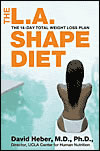
The L.A. Shape Diet
By David Heber, MD, PhD
Heber is the founding director of the Center for Human Nutrition at the University of California at Los Angeles, and he based the book on a weight loss plan he developed for himself, then adapted for his patients. Heber's diet is very low in calories and requires that 29 percent of them be protein. He also recommends that for the first week or so, much of the protein come in the form of twice-a-day shakes packed with fruit, milk, protein powder, and a meal-replacement powder containing essential nutrients. For dinner he offers standard healthy fare, such as oven-fried fish served with steamed veggies. In the second week, solid food can be substituted for the lunchtime shake, but the liquid breakfast remains. Much of the book is devoted to exercise, meditation, motivation, and how to adopt a healthy lifestyle.
What the experts like: The L.A. Shape Diet promotes a wide variety of fresh produce, "and it really talks about the importance of exercise," Nelson says. Christina Economos, PhD, also praises the lengthy discussion of how to prevent a relapse, which many diet authors neglect.
What they don't like: The biggest drawback is the diet's overreliance on shakes. "People like taste and textures," Nelson says, and some studies have shown people to be more satisfied when they eat solid foods versus liquids. Also, Economos points out, buying all the powders and supplements could get expensive.
Crunching the numbers: Very low calorie, around 1,100 per day, with double the amount of recommended protein. There's plenty of fiber and not too much fat, but the diet is lacking in vitamin E and calcium.
By David Heber, MD, PhD
Heber is the founding director of the Center for Human Nutrition at the University of California at Los Angeles, and he based the book on a weight loss plan he developed for himself, then adapted for his patients. Heber's diet is very low in calories and requires that 29 percent of them be protein. He also recommends that for the first week or so, much of the protein come in the form of twice-a-day shakes packed with fruit, milk, protein powder, and a meal-replacement powder containing essential nutrients. For dinner he offers standard healthy fare, such as oven-fried fish served with steamed veggies. In the second week, solid food can be substituted for the lunchtime shake, but the liquid breakfast remains. Much of the book is devoted to exercise, meditation, motivation, and how to adopt a healthy lifestyle.
What the experts like: The L.A. Shape Diet promotes a wide variety of fresh produce, "and it really talks about the importance of exercise," Nelson says. Christina Economos, PhD, also praises the lengthy discussion of how to prevent a relapse, which many diet authors neglect.
What they don't like: The biggest drawback is the diet's overreliance on shakes. "People like taste and textures," Nelson says, and some studies have shown people to be more satisfied when they eat solid foods versus liquids. Also, Economos points out, buying all the powders and supplements could get expensive.
Crunching the numbers: Very low calorie, around 1,100 per day, with double the amount of recommended protein. There's plenty of fiber and not too much fat, but the diet is lacking in vitamin E and calcium.
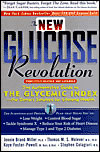
The New Glucose Revolution
By Jennie Brand-Miller, PhD; Thomas Wolever, MD, PhD; Kaye Foster-Powell; Stephen Colagiuri, MD
Originally conceived to aid diabetics, the glycemic index is a way of measuring the effect a carbohydrate food has on blood sugar. Now several researchers of the index say it can help healthy people lose weight. By consuming foods that are more slowly digested (lower on the index), they claim, you feel less hungry and eat fewer calories.
What the experts like: Most gave this diet a big thumbs-up. Lash and Economos agree that the foods recommended are generally healthy and that the book offers clear guidelines. "It's particularly good at describing the difference between healthy and unhealthy carbohydrates," says Perry-Bottinger.
What they don't like: The main criticism is that the glycemic index is a good concept, but it's been taken too far. Instead of obsessing over what glycemic rating a piece of bread has, says Nelson, "it's the whole pattern of the diet that makes the difference—the variety of nuts, seeds, lean meats, legumes, fruits, vegetables, grains. If you forget about the index and focus on those foods, you'll see improvement in almost every area, from cholesterol to weight loss."
Crunching the numbers: At about 1,800 calories a day, the diet is fairly balanced—moderate in carbohydrates and protein, low in fat, with plenty of fiber. Its only notable deficiencies are vitamins D and E.
By Jennie Brand-Miller, PhD; Thomas Wolever, MD, PhD; Kaye Foster-Powell; Stephen Colagiuri, MD
Originally conceived to aid diabetics, the glycemic index is a way of measuring the effect a carbohydrate food has on blood sugar. Now several researchers of the index say it can help healthy people lose weight. By consuming foods that are more slowly digested (lower on the index), they claim, you feel less hungry and eat fewer calories.
What the experts like: Most gave this diet a big thumbs-up. Lash and Economos agree that the foods recommended are generally healthy and that the book offers clear guidelines. "It's particularly good at describing the difference between healthy and unhealthy carbohydrates," says Perry-Bottinger.
What they don't like: The main criticism is that the glycemic index is a good concept, but it's been taken too far. Instead of obsessing over what glycemic rating a piece of bread has, says Nelson, "it's the whole pattern of the diet that makes the difference—the variety of nuts, seeds, lean meats, legumes, fruits, vegetables, grains. If you forget about the index and focus on those foods, you'll see improvement in almost every area, from cholesterol to weight loss."
Crunching the numbers: At about 1,800 calories a day, the diet is fairly balanced—moderate in carbohydrates and protein, low in fat, with plenty of fiber. Its only notable deficiencies are vitamins D and E.
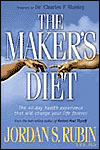
The Maker's Diet
By Jordan S. Rubin, NMD, PhD
Rubin, a naturopathic doctor, bases his diet on the whole grains, saturated fats, red meat, and unprocessed foods (such as raw, unpasteurized goat's milk and cheese) eaten during biblical times. And because hormone injections, pesticides, and other staples of today's food industry hadn't yet been introduced, he also recommends eating organic when possible. He lays out a three-phase, 40-day plan evoking Moses' journey and Lent, each phase allowing a greater choice of foods than the previous one, and suggests a partial fast every seven days with dinner as the only meal; morning and evening prayers are part of the program. Rubin also prescribes a regimen of supplements, aromatherapy, and hygiene that requires dieters to purchase a number of items, many developed by Rubin himself.
What the experts like: Economos applauds "the concept of organic, free-range meat and getting people to eat a wider variety of less-processed foods." And this, she says, is the only book of the group that emphasizes a spiritual component, which may give some readers the extra motivation they need to stick to the diet.
What they don't like: "There's an incredible amount of commercialism and product endorsement in the book," Nelson says, and purchasing the recommended pills and potions would be costly. In addition, Economos cautions that fasting, while not always harmful, can be dangerous for people with high blood pressure or diabetes, both of which are common in obese individuals. "Plus," she says, "deprivation primes people for binges." Lash also takes issue with the author's superior tone: "He goes out of his way to put down various kinds of medical care other than the one he espouses." Bottom line, he says, "It's a diet I wouldn't recommend to anyone."
Crunching the numbers: Not counting the partial fasts, daily calories start at about 1,650 and increase to roughly 1,800 by phase two. In the first phase, fat is a whopping 58 percent of total calories, but by the time you get to maintenance, it's lowered to a healthy amount. The diet is low in calcium and vitamin D.
By Jordan S. Rubin, NMD, PhD
Rubin, a naturopathic doctor, bases his diet on the whole grains, saturated fats, red meat, and unprocessed foods (such as raw, unpasteurized goat's milk and cheese) eaten during biblical times. And because hormone injections, pesticides, and other staples of today's food industry hadn't yet been introduced, he also recommends eating organic when possible. He lays out a three-phase, 40-day plan evoking Moses' journey and Lent, each phase allowing a greater choice of foods than the previous one, and suggests a partial fast every seven days with dinner as the only meal; morning and evening prayers are part of the program. Rubin also prescribes a regimen of supplements, aromatherapy, and hygiene that requires dieters to purchase a number of items, many developed by Rubin himself.
What the experts like: Economos applauds "the concept of organic, free-range meat and getting people to eat a wider variety of less-processed foods." And this, she says, is the only book of the group that emphasizes a spiritual component, which may give some readers the extra motivation they need to stick to the diet.
What they don't like: "There's an incredible amount of commercialism and product endorsement in the book," Nelson says, and purchasing the recommended pills and potions would be costly. In addition, Economos cautions that fasting, while not always harmful, can be dangerous for people with high blood pressure or diabetes, both of which are common in obese individuals. "Plus," she says, "deprivation primes people for binges." Lash also takes issue with the author's superior tone: "He goes out of his way to put down various kinds of medical care other than the one he espouses." Bottom line, he says, "It's a diet I wouldn't recommend to anyone."
Crunching the numbers: Not counting the partial fasts, daily calories start at about 1,650 and increase to roughly 1,800 by phase two. In the first phase, fat is a whopping 58 percent of total calories, but by the time you get to maintenance, it's lowered to a healthy amount. The diet is low in calcium and vitamin D.

Eat Right for Your Type
By Peter J. D'Adamo, nD, with Catherine Whitney
This weight loss plan, often referred to as the blood-type diet, proposes that a person should eat according to the foods that were common during the time in history when her specific blood type evolved. Those with the oldest, type O, for instance, are advised to consume the foods of ancient hunter-gatherers, while people with type A, which surfaced in the first agrarian era, should be largely vegetarian. D'Adamo, a naturopathic physician, cites some research (including his own and his father's) to support the assertion that individual blood types have different chemical reactions to the same foods and that this can affect weight gain. To help his readers find the right balance, D'Adamo divides food into three categories for each blood type—the highly beneficial, the neutral, and items to avoid.
What the experts like: The foods suggested in the individual diets are basically healthy. "In the end," Nelson says, "it's about cutting out the junk and eating whole foods." In fact, says Perry-Bottinger, "what he's recommending for each blood type is good for every blood type."
What they don't like: D'Adamo may tout his sources, but Lash concludes, "there's no scientific evidence to support what's in Eat Right for Your Type. It's silly. You can get equally good dietary advice by reading your horoscope." Economos agrees, saying "there's no randomized clinical trial to show that anyone who eats a diet based on his or her blood type is successful." And both she and Perry-Bottinger worry that D'Adamo's theories will prevent some people from eating foods, such as avocado, tofu, and legumes, that have been shown to be beneficial to just about everyone.
Crunching the numbers: Those with type B blood are allowed the most calories per day, at roughly 1,750, and type A the fewest, with less than 1,200. The type O plan is low in fiber, iron, calcium, and vitamins D and E, and high in cholesterol. The type A plan is also low in fiber and iron as well as vitamins E and D. Type AB is low in fiber, folate, vitamin E, calcium, magnesium, and zinc. Type B has the fewest deficiencies, but it is lacking in vitamin E and iron.
By Peter J. D'Adamo, nD, with Catherine Whitney
This weight loss plan, often referred to as the blood-type diet, proposes that a person should eat according to the foods that were common during the time in history when her specific blood type evolved. Those with the oldest, type O, for instance, are advised to consume the foods of ancient hunter-gatherers, while people with type A, which surfaced in the first agrarian era, should be largely vegetarian. D'Adamo, a naturopathic physician, cites some research (including his own and his father's) to support the assertion that individual blood types have different chemical reactions to the same foods and that this can affect weight gain. To help his readers find the right balance, D'Adamo divides food into three categories for each blood type—the highly beneficial, the neutral, and items to avoid.
What the experts like: The foods suggested in the individual diets are basically healthy. "In the end," Nelson says, "it's about cutting out the junk and eating whole foods." In fact, says Perry-Bottinger, "what he's recommending for each blood type is good for every blood type."
What they don't like: D'Adamo may tout his sources, but Lash concludes, "there's no scientific evidence to support what's in Eat Right for Your Type. It's silly. You can get equally good dietary advice by reading your horoscope." Economos agrees, saying "there's no randomized clinical trial to show that anyone who eats a diet based on his or her blood type is successful." And both she and Perry-Bottinger worry that D'Adamo's theories will prevent some people from eating foods, such as avocado, tofu, and legumes, that have been shown to be beneficial to just about everyone.
Crunching the numbers: Those with type B blood are allowed the most calories per day, at roughly 1,750, and type A the fewest, with less than 1,200. The type O plan is low in fiber, iron, calcium, and vitamins D and E, and high in cholesterol. The type A plan is also low in fiber and iron as well as vitamins E and D. Type AB is low in fiber, folate, vitamin E, calcium, magnesium, and zinc. Type B has the fewest deficiencies, but it is lacking in vitamin E and iron.
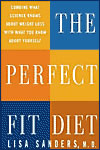
The Perfect Fit Diet
By Lisa Sanders, MD
Working on the premise that no one diet fits all, Sanders, an internist, takes readers through an extensive questionnaire to determine whether counting carbs, fats, or calories will work best for them. Then she helps readers customize their weight loss plan to incorporate personal taste, behavior patterns, and medical history.
What the experts like: Both Perry-Bottinger and Lash found this to be the best of the bunch. "The reason I like it is the reason I think it's the lowest of these books on the Amazon sales list," says Lash: "It doesn't have any gimmicks." Economos is wary of the Counting Carbs option, but gives Sanders points for asking her readers to keep a food and exercise diary during the week before they start. "It puts responsibility on the individual," she says. "When I have people do that for me, it changes the way they eat."
What they don't like: Lash suspects most people would prefer more rules. And the experts generally agree that the calorie count for each of the three diets is a bit low, making maintenance difficult, especially for people who are exercising.
Crunching the numbers: Depending on the method, daily calories total 1,200 to about 1,350. The Counting Fats plan has plenty of fiber and emphasizes the "good" fats, although it doesn't include enough zinc or vitamins B12 and E. Counting Calories also has fiber but is deficient in vitamins D and E, and iron. Counting Carbs is the least healthy: low in fiber, thiamin, vitamins D and E, iron, magnesium, and zinc, and high in fat, which provides more than 200 percent of the RDA of cholesterol.
By Lisa Sanders, MD
Working on the premise that no one diet fits all, Sanders, an internist, takes readers through an extensive questionnaire to determine whether counting carbs, fats, or calories will work best for them. Then she helps readers customize their weight loss plan to incorporate personal taste, behavior patterns, and medical history.
What the experts like: Both Perry-Bottinger and Lash found this to be the best of the bunch. "The reason I like it is the reason I think it's the lowest of these books on the Amazon sales list," says Lash: "It doesn't have any gimmicks." Economos is wary of the Counting Carbs option, but gives Sanders points for asking her readers to keep a food and exercise diary during the week before they start. "It puts responsibility on the individual," she says. "When I have people do that for me, it changes the way they eat."
What they don't like: Lash suspects most people would prefer more rules. And the experts generally agree that the calorie count for each of the three diets is a bit low, making maintenance difficult, especially for people who are exercising.
Crunching the numbers: Depending on the method, daily calories total 1,200 to about 1,350. The Counting Fats plan has plenty of fiber and emphasizes the "good" fats, although it doesn't include enough zinc or vitamins B12 and E. Counting Calories also has fiber but is deficient in vitamins D and E, and iron. Counting Carbs is the least healthy: low in fiber, thiamin, vitamins D and E, iron, magnesium, and zinc, and high in fat, which provides more than 200 percent of the RDA of cholesterol.




